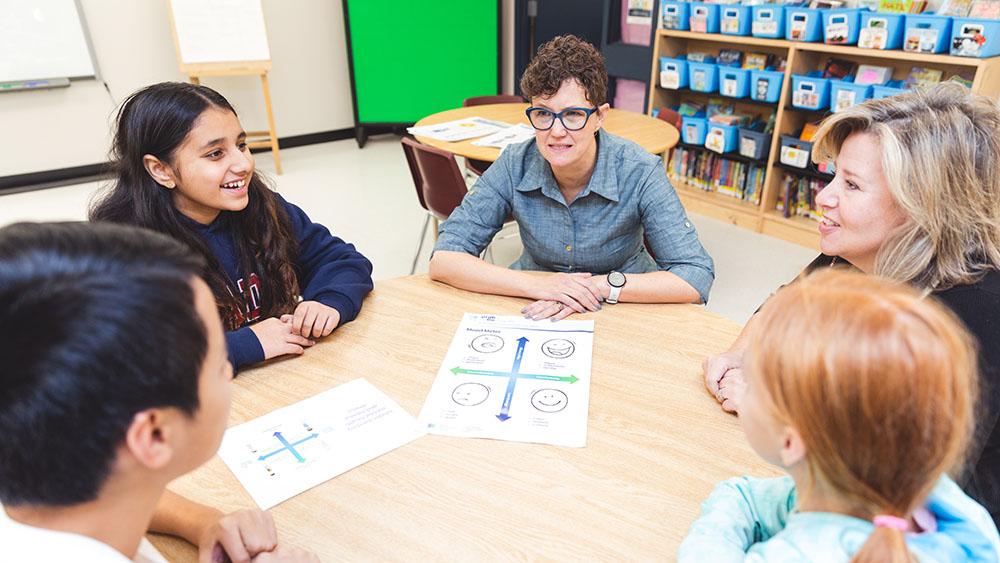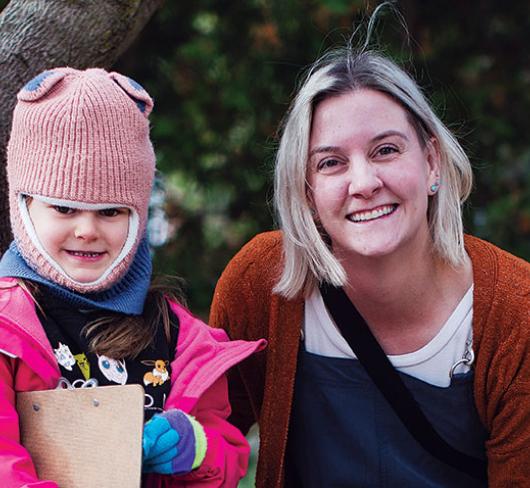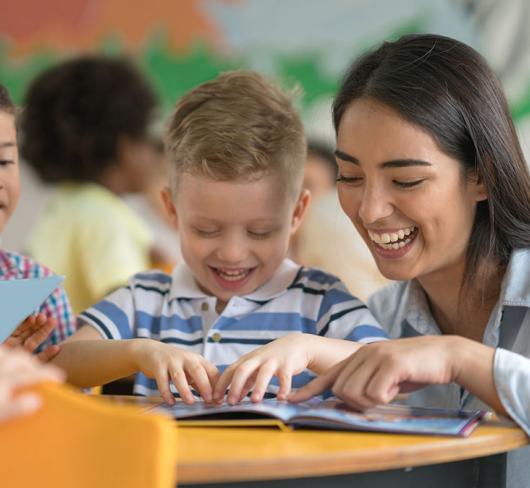
Weaving the Threads of Well-being
“A good life is like a weaving. Energy is created in the tension. The struggle, the pull and tug are everything.” — Joan Erikson
Reading this quote triggers a visual for me of the pull and tug that educators face everyday. We are pulled between teaching curriculum and supporting the diverse needs of students. We feel a tug between politics and our desire to create learning spaces for our students to thrive in. There is tension between finding balance in our work and our personal lives. When I pause and allow my mind to settle, I am able to see the beauty in these struggles and take time to view these pulls and tugs as the magic needed to create a good life in teaching for myself and the students I have the privilege of educating. For me, the beauty is found in the work of weaving the threads of well-being into my own practice and those of the teachers I collaborate with.
In the 2022-23 school year, I embarked on a new teaching journey as a well-being facilitator with my school board’s mental health and well-being team. The vision for this role is to work with teachers, schools, and surrounding communities to champion student mental health by creating the conditions for social, emotional, physical, spiritual and cognitive well-being to flourish in the classroom and beyond. What became apparent early in my work was the old phrase, “You can’t pour from an empty cup.” If educators are struggling with their own well-being, it is difficult to support their students. With this in mind, I became interested in looking at how to integrate well-being teaching and learning into the classroom so that it not only benefits students but also the educators delivering this learning. Our team set out to research how this could be done.
Finding the Right Resources
We wanted the resources to be evidence-based, Canadian and with a focus on supporting well-being for everyone in the classroom. We looked for resources that are identity-affirming and differentiated. We made a commitment to centre historically marginalized voices and perspectives and to keep in mind the needs of both educators and students. The resources needed to be practical, easy to implement, and provide a range of activities and learning opportunities for students and staff. The following resources met our criteria:
- School Mental Health Ontario (smho-smso.ca)
- The Third Path - thirdpath.ca
- Ensouling our Schools: A Universally Designed Framework for Mental Health, Well-Being, and Reconciliation by Jennifer Katz (Portage and Main Press)
- Teacher, Take Care by Jennifer E. Lawson, ed. (Portage and Main Press)
These resources look at mental health as part of one’s well-being by reflecting on the connection between heart, mind and body. They focus on increasing skills and reducing stigmas around mental health.
What We Learned
“The learning activities that teachers do with a focus on student well-being also have the power to enhance the teachers’ well-being. They are interconnected.”
– Teacher, Take Care
Educators naturally integrate experiences, activities and learning opportunities into their daily practices that support positive mental health. But when educators plan with intention to weave well-being learning into their classroom and learning experiences, it not only benefits the students, it also rewards the educator. But what does well-being look like, sound like, and feel like in the classroom while also acknowledging the need to teach curriculum?
Defining Well Being
The place to start was to have a clear definition of what well-being means. The World Health Organization defines well-being as “a positive state experienced by individuals and societies… Well-being encompasses quality of life and the ability of people and societies to contribute to the world with a sense of meaning and purpose.” It is important to understand that well-being is individual and not a one-size-fits-all state of being. Therefore, it is necessary to understand and cultivate the conditions for well-being to flourish.
For schools, the conditions for well-being are rooted in having an identity-affirming and mentally healthy learning environment, as well as trusting relationships with caring adults. Well-being is strengthened by having meaningful connections with peers, educators, caring adults, families and the community in which the student lives and goes to school. When these conditions are in place, a person’s social, emotional, physical, cognitive and spiritual well-being can flourish. As a team, our goal was to establish what this might look like in classrooms across our school board.
Weaving Well-Being
The weaving of well-being began with educators opening their classroom doors and allowing our team to plan and teach well-being strategies within their daily schedule. Our team supported 17 elementary schools in our first year. Educators from Kindergarten to Grade 8 welcomed us into their classrooms, which amounted to close to 900 lessons being shared. We tried a number of approaches grounded in Tier 1 intervention from the Aligned and Integrated Model (AIM) from School Mental Health Ontario (SMH-ON). Some of the strategies we found most engaging and supportive of student mental health were:
Welcome
- Greet students when they enter the classroom, not only at the beginning of the day but after transitions (such as after recess).
- Have co-created classroom norms that honour student voice and are reviewed and updated regularly (e.g., paying attention to what helps you learn and honouring that others may need different methods). Setting this learning norm can help fuel discussions about what helps individuals focus, such as doodling while listening.
- Begin with belonging. Have opportunities to start the day with conversations, connections and activities that promote collaboration, such as time to eat snacks, creating a puzzle at a table, having a “complete the comic” worksheet on the table, or having a “would you rather” question on the board for students to discuss.
- Reflect student voice and choice in the classroom environment. Examples of this include documenting classroom discussions on an anchor chart and putting students’ names beside their contributions, providing students with different options to show learning, and allowing students opportunities to share their learning and expertise with each other through inquiry projects.
Include
- Use activities in the classroom that allow students to share about themselves, such as the SMH-ON activity titled “That’s Me,” in which a student shares something about themselves (e.g., “I have three siblings”) and anyone else in the class who has that in common raises their hand and says, “That’s me.”
- Allow students to have a chance to be a leader. For example, have students provide a daily dedication prior to a lesson or sharing of a topic.
- Integrate activities for students to learn about others in their class. The activity “I in Image” from SMH-ON has students choose an image that reflects something about themselves and then share why they chose that image.
Understand
- Educators completed a free six-hour mental health literacy course from SMH-ON and applied the learning to their daily practice.
- Share clear definitions of mental health and mental illness to reduce the stigma of talking about mental health.
Promote
- Integrate evidence-based social-emotional skills lessons from the online Everyday Mental Health Classroom Resource created by SMH-ON and ETFO.
- Have students create products (videos, posters, comics, memes) to share mental health promotion with one another and the school community.
Partner
- Provide parents and caregivers information about what students are learning about social-emotional skills and mental health at school so they can reinforce skills at home.
Continuation and Sustainability of Implementation
The work of weaving well-being into everyday classroom practices is a continuous process; it is not a destination but a journey. To continue and sustain the work, SMH-ON has created a tool called Wayfinder, which provides 10 sequential learning opportunities, organized by grade, for integrating mental health learning into the classroom. The tool provides core lessons related to strand D of the Ontario Health curriculum, and shares reinforcing and skill-building activities to foster positive mental health. There are also consolidation learning opportunities provided to ensure the learning from the year is meaningful and translatable to all aspects of a student’s life. By using this tool, educators teach core mental-health learning connected to the Health and Physical Education curriculum, expose and model coping strategies, and provide guidance to consolidate the learning. Integrated resources range from “press and play” videos to lesson plans to parent/caregiver communications.
Ultimately, we as educators, want all students to be their best selves. We can support their learning about themselves and the strategies that aid them to navigate the ups and downs of life by ensuring that well-being is an integrated part of their day.
The Ultimate Outcome
At the beginning of this piece, I mentioned that “you can’t pour from an empty cup.” Through this process, our team discovered that while that’s true, you can refill your cup as an educator. By intentionally integrating well-being strategies and ideas into the classroom and school environment, not only does student mental health flourish, educator mental health is also supported. Educators who practice these strategies with their students and create planned, purposeful, and sustainable mental-health learning opportunities begin to replenish themselves while building student skills. The acts of modeling, engaging and learning alongside students about mental health and coping strategies provides us, as educators, exposure to a variety of mental health coping tools. For example, we can model the use of the five-finger breathing mindfulness technique to draw the attention of a talkative class. If we pair the strategy with the instruction “If you can hear me, breathe with me,” we help the class settle and refocus, and help ourselves remain in a state of balance, which supports our own mental health.
Sue Ducau is a member of the Simcoe County Teacher Local.

